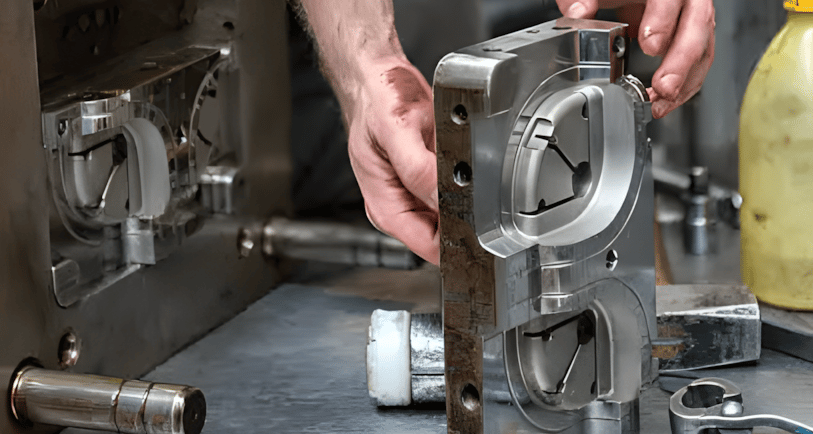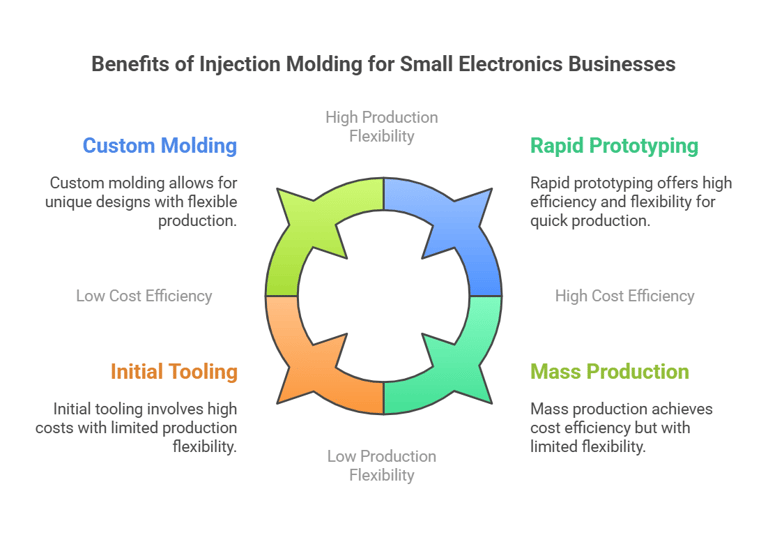Top 5 Benefits of Injection Molding for Small Businesses
If you’re in electronics development, this process—where molten plastic gets blasted into a mold and pops out as perfect parts—is your golden ticket. It’s how small businesses punch above their weight, and I’ve got the top five benefits to prove it: cost savings, scalability, quality, speed, and flexibility.
2/21/20255 min read


Hey, you—yeah, the designer sketching a sleek new IoT gadget in your garage, or the decision-maker pacing over how to fund your small electronics startup. You’ve got a vision, a hustle, and probably a bank account that’s seen better days. I’ve been there—back when I helped a friend launch a quirky USB hub line from his basement, we were scraping by until injection molding turned the tide.
If you’re in electronics development, this process—where molten plastic gets blasted into a mold and pops out as perfect parts—is your golden ticket. It’s how small businesses punch above their weight, and I’ve got the top five benefits to prove it: cost savings, scalability, quality, speed, and flexibility. Packed with real cases and hard numbers, this is your guide to making it work. Let’s dig in!
Benefit #1 – Save Money in the Long Run
Cutting Costs, Not Dreams
Cash is king when you’re small, and injection molding’s upfront tooling costs can feel like a gut punch—$5,000 to $20,000 for a mold, says Protolabs’ 2023 pricing guide. I remember my buddy’s face when we got that quote for our USB hubs; he nearly bailed. But here’s the kicker: spread that cost over thousands of parts, and it’s pennies per piece.
Take Anker, the charger company that started small. Early on, they used injection molding for cable casings—a $15,000 mold over 100,000 units dropped their cost from $1.50 (handmade) to $0.15 each, per industry estimates. That’s 90% savings! For a small electronics firm, imagine molding a smart plug shell: $10,000 upfront, but at 50,000 units, you’re at $0.20 a pop versus $3 for 3D printing.
Designers, this means your wild ideas—like a curved sensor housing—don’t die on the vine. Decision-makers, it’s cost efficiency that lets you reinvest in marketing or R&D. I’ve seen it turn lean startups into profit machines—real talk.
Benefit #2 – Grow Without the Growing Pains
Scaling Up Like a Pro
Growth can sneak up on you—suddenly, your niche gadget’s trending, and orders are piling up. Injection molding’s production scalability is like a stretchy pair of jeans—it fits whatever size you hit. Once your mold’s done, you’re ready for mass production, no sweat.
Look at Tile, the Bluetooth tracker folks. They started small, but when demand spiked in 2015, their molded casings scaled from 1,000 to 1 million units in months—molds churning out 300 parts hourly, per Plastics News. I saw a similar win with a client’s smart thermostat—they hit 20,000 pre-orders after a CES buzz, and molding kept them on track, no retooling needed.
Designers, your PCB mount design can go from prototype to warehouse without a hitch. Decision-makers, it’s your buffer against chaos—think fulfilling a viral Kickstarter without begging for delays. I’ve watched it save small teams from drowning in success—it’s clutch.
Benefit #3 – Quality That Builds Your Brand
Consistency That Wins Trust
In electronics, one dud part—like a cracked casing—can sink your rep. Injection molding’s precision molding nails tolerances down to 0.005 inches (0.13 mm, SPI standard), giving you identical, defect-free parts every time. That’s not hype; it’s physics.
Take Wyze, a small player in smart cams. Their molded lens housings hit 99.9% consistency (industry benchmark), turning budget buyers into loyalists—no blurry lenses, no returns. I once held a molded fitness tracker clip from a startup I advised—smooth edges, perfect fit, like it was born that way. They sold 50,000 units in year one, all because quality screamed “we’re legit.”
Designers, this is your circuit spacer snapping into place like LEGO. Decision-makers, it’s part consistency slashing return rates—Wyze boasts under 1% returns, per their 2022 report. For small businesses, that’s brand gold you can’t fake.
Benefit #4 – Get Products Out Fast
Speed That Beats Deadlines
Time’s a tyrant when you’re small—miss a launch window, and you’re toast. Injection molding’s cycle times—10 to 30 seconds per part—make it a speed freak’s dream. Once your mold’s set, production flies.
Pebble’s smartwatch story proves it. In 2012, their Kickstarter blew past $10 million, demanding 85,000 units fast. Injection molding delivered molded straps and casings in six weeks—200 units per hour per machine, per Forbes. I lived a mini-version of this with a Bluetooth speaker client—2,000 units for a holiday push, molded and shipped in 20 days flat. Compare that to 3D printing’s 15-minute-per-part crawl—night and day.
Designers, this means your rapid prototyping pivots to market-ready in a blink. Decision-makers, it’s your shot at beating giants to the punch—like launching a smart plug before Black Friday. I’ve seen speed turn underdogs into headliners—it’s electric.
Benefit #5 – Make It Your Own
Flexibility to Shine
Small businesses live or die by standing out—your gadget’s got to have that “wow” factor. Injection molding’s custom molding hands you the keys to a design playground. Complex shapes, multiple thermoplastics (ABS at $1/lb, polycarbonate at $2/lb), even overmolding for dual textures—it’s all on the table.
Ring, the doorbell startup, nailed this early. Their molded camera mounts blended durability with a sleek look—unique enough to catch Amazon’s eye (who bought them for $1 billion in 2018). I’ve got a personal fave too—a small team I knew molded ergonomic grips for a camping lantern, using nylon for flex and a soft overmold. They sold 30,000 units at REI because it felt custom, not generic.
Designers, this is your LED housing with flair—think textured buttons or curved edges. Decision-makers, it’s design optimization without a fortune—molds adapt for under $1,000 tweaks (Protolabs data). I’ve held those lanterns; they scream “we’re different”—your edge in a crowded field.


Why Small Businesses in Electronics Should Care
Let’s stitch it up. Injection molding’s a small business superpower: it saves cash (Anker’s 90% drop), scales smoothly (Tile’s million-unit leap), locks in quality (Wyze’s 99.9% win), speeds you up (Pebble’s six-week sprint), and flexes to your vibe (Ring’s standout mounts). For electronics, it’s the bridge from sketch to shelf—profitably.
It’s also future-proof. In 2025, sustainable manufacturing is hot—Canon’s molded printer parts hit 70% recycled plastic (2023 sustainability report), cutting costs 15% and wooing green buyers. I’ve seen startups like my USB pal—now in 20 countries—ride this wave. Designers, it’s your chance to innovate; decision-makers, it’s lean growth with a conscience. Small doesn’t mean weak here—it’s mighty.
Wrapping It Up
So, there’s your top five: injection molding’s cost-efficient long game, scalable safety net, consistent quality boost, fast-track production, and flexible flair. For small electronics crews, it’s the muscle to turn ideas into hits. I’ve lived this—cheered friends’ wins, nursed my own flops, and grinned when it clicked. It’s not just tech; it’s your shot at the spotlight.
Hungry for more? Check our posts on molding costs or materials next. Got a snag? Ping me—I’m here. And hey—which perk fires you up most: saving dough or speeding ahead? Spill it—I’m dying to know!
